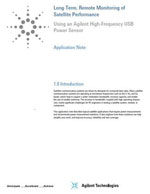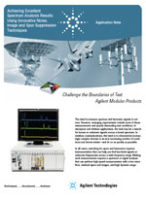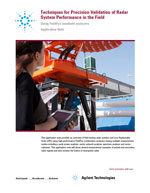White Papers
May 19, 2014
Next generation radar systems face multiple difficult demands. The pace and variety of new requirements need multi-use/function/mode adaptive radars, to be used for different applications. This whitepaper reviews existing pulse measurement test methods; discusses advantages/limitations; and introduces new test method that takes advantage of high-speed digitizing architecture, offering the industryâ??s highest resolution/timing accuracy level.
April 15, 2014
Many passive multiport devices - such as power dividers/combiners, baluns, hybrids, and impedance transformers - rely on electromagnetic (EM) coupling for their intended functions. In the microwave range this is typically achieved through a usage of capacitive (electrical) coupling between the closely spaced transmission lines. Adding the magnetic coupling by utilizing the ferrite-loaded transmission lines allows significantly expanding the operation band both up and down in frequencies. This paper provides the theoretical explanation for such a broad frequency effect of ferrite materials and illustrates the theory by presenting the 3-D simulation results for 2:1 impedance ratio ferrite transmission-line transformer.
April 15, 2014
To amplify weak signals received by the antenna in communication systems, low noise amplifiers (LNAs) are deployed. LNAs are used in various applications such as GPS receivers, wireless data systems, satellite communications, cellular handsets, radio systems, etc..
April 15, 2014
The use of printed microstrip couplers in power amplifiers operating at microwave frequencies above 1 GHz has been well established and numerous papers have been written about the design of such structures. It is surprising, however, that little has been written about the subject of printed baluns (BALanced to UNbalanced) - electrical devices that convert between a balanced signal and an unbalanced signal. Even more surprising is that the dominant approach to power combining at VHF and UHF is via coaxial cables, which comes with inherent assembly, cost, and thermal issues.
March 17, 2014
AR RF/Microwave Instrumentation offers a broad range of power amplifiers covering DC to 45 GHz with output power ranging from 1 to 16,000 watts. While applications include Electromagnetic Compatibility testing (EMC), RF component testing, physics (plasma generation) and chemistry (mass spectroscopy) applications, military (jammers, radar), material testing (ultrasound), medical diagnostic testing (NMR, MRI) and general lab use, this applications note focuses on a line of amplifiers that has been optimized for wireless telecommunications test use.
March 17, 2014
This application note describes typical satellite applications that require power measurements and recommends power measurement solutions. It also explains how these solutions can help simplify your work, and improve accuracy, reliability and test coverage. Also covered are new sensor functions such as built-in Gamma and S-parameter corrections and real time measurement uncertainty calculations for improved accuracy.
March 17, 2014
The need to measure spurious and harmonic signals is not new. However, emerging requirements include more of these measurements and specify demanding test conditions. In aerospace and defense applications, the task may be a search for known or unknown signals across a broad spectrum. In wireless communications, the need is to characterize increasingly complex devices in an ever-expanding number of conditions and device states - and do so as quickly as possible.
March 17, 2014
This application note provides an overview of field testing radar systems and Line Replaceable Units (LRU) using high-performance� FieldFox combination analyzers having multiple measurement modes including a peak power analyzer, vector network analyzer, spectrum analyzer and vector voltmeter. This application note will show several measurement examples of pulsed and secondary radar signals and also reviews the basics of� monopulse radar.
March 17, 2014
Accel-RF President, Roland Shaw, outlines the recent history and current trends for reliability testing and quality assurance to keep up with the shift in GaN from "research novelty" to "market reality". This white paper will give a detailed overview in the development of GaN devices and MMICs from a reliability and burn-in test perspective.
February 18, 2014
When using a power meter that references to a 50 MHz, 1 mW output power reference it is important to know that the 50 MHz reference is within the specified performance limits. The TEGAM Model 1830A RF Power Meter coupled with a thermistor power sensor (also known as a thermistor mount) can accurately measure the SWR of a 50 MHz reference. By utilizing a unique function that most modern power meters do not offer; the 1830A allows the user to change the value of the thermistor mounts terminating resistance. Utilizing this method for measuring source match works well because it presents the source with two distinctly different values of Î?_Load which allows accurate measurement of the power absorbed under two different conditions. This application note will explain how we make this SWR measurement with the 1830A and a thermistor mount.









